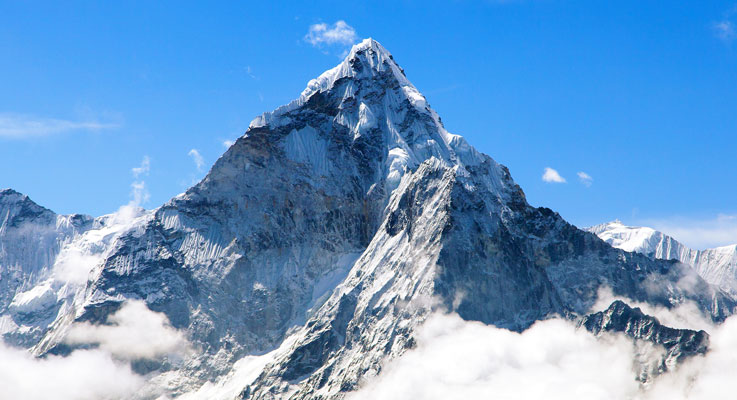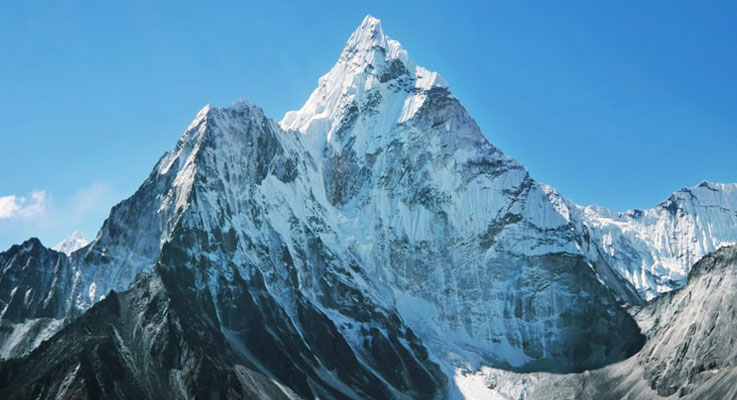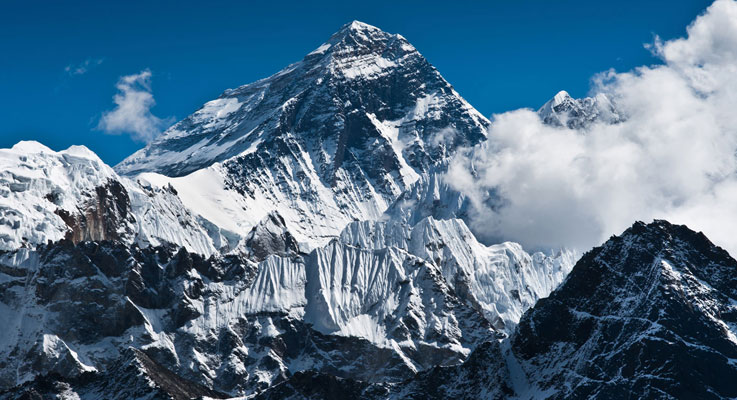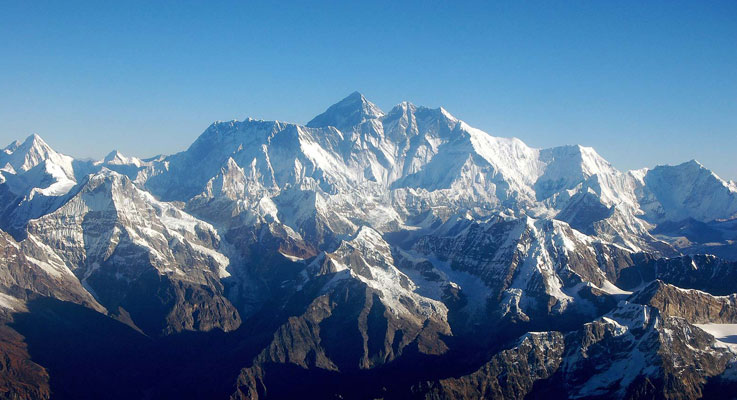-
Day 1
Arrival in Kathmandu (1,345m/4,413 ft)
Upon arriving at at Tribhuwan International Airport in Kathmandu, you will be received by our airport representatives who will warmly greet you and transfer to the hotel on a private tourist vehicle. We provide 3-star accommodation in the city and we arrange for a trip briefing with dinner in the evening.
-
Day 2
Visit old town of Kathmandu
A professional guide and vehicle are provided for a day of sightseeing in and around Kathmandu city. We visit some of the UNESCO World Heritage Sites in the city along with other interesting cultural monuments that dot the valley. These include Boudhanath Stupa (the largest Buddhist shrines in the world), Pashupatinath (the holiest Hindu temple in the world), Durbar Squares (Palaces and fortresses of medieval Kings), along with other popular cultural attractions. We get to observe the lifestyle of Nepalese people, holy sadhus and monks, fascinating history as well as awe-inspiring architecture.
-
Day 3
Fly from Kathmandu to Lukla (2,800m/9,186 ft). Trek to Phakding (2,610m/8,563 ft)
Early in the morning, you will be transferred to the airport in Kathmandu for a scenic 30-minute flight to Lukla. The airport guide will brief you and introduce our porters before we begin our trek towards Phakding (2,610m). There will be some time to explore the village while our Sherpa crew sorts and loads trekking equipment and baggage. The trek starts with a descent to Dudh Kosi River, from where the wider trail leads us to the village of Ghat (2,550m), and then to Phakding on an easy-paced walk.
-
Day 4
Trek from Phakding to Namche Bazar (3,440m/11,286 ft)
Walking along the shores of Dudh Kosi, we get to cross the serene river many times on exhilarating suspension bridges decorated with prayer flags. A little further, we enter Sagarmatha National Park from where the trail climbs steeply with picturesque sights. After trekking for a few hours, we reach Namche Bazaar, known as the Gateway of Everest.
-
Day 5
Namche Bazaar acclimatization day
In order to acclimatize to the altitude gained and thinner air, we spend a day in Namche Bazaar. There are several quality restaurants, hotels, lodges, shops, money exchange services, internet cafes and bakeries at this town, also the largest in the Everest region. We pay a visit to the museum nearby known for its traditional artefacts that showcase the Sherpa culture. We also hike to Syangboche Airport from where we can see rewarding vistas of stunning sunrise and sunset over the Himalayan panorama.
-
Day 6
Trek from Namche Bazaar to Deboche (3,800m / 12,467ft)
We ascend out of the village and follow a high, fairly level path above the Dudh Kosi enjoying spectacular mountain views of Everest, Nuptse and Lhotse as we go. We pass the various shops set up by Tibetans selling trinkets and then descend through forest of blue pine to cross the Dudh Kosi again at Phunki (3,250m). We make another ascent on a switchback trail, sometimes made quite dusty by yak trains, to reach the spectacularly sited Thyangboche Monastery (3,867m) from where there are brilliant views of Everest, Lhotse, Nuptse, Ama Dablam and Taboche to the north and northeast, Thamserku and Kantega to the southeast and Kwangde to the southwest. Thyangboche Monastery was seriously damaged by fire in 1989 but has since been rebuilt and there will be time to visit both the monasteries and a museum. We reach our teahouse at Deboche. 6 hours walk.
-
Day 7
Trek from Deboche to Orsho (4,130m / 13,550ft)
Descend through meadows and Rhododendron forest, past the Buddhist nunnery at Deboche to cross Imja Khola (river) and up to pass village of Pangboche. Now above the tree line, climb up to the Orsho (4,100m). Approx 4.5 hrs walk mostly ascending. 120m descent 340m ascent.
-
Day 8
Trek from Orsho to Dingboche (4,350m/14,272 ft)
Gradually climb up hill to the confluence of the Khumbu and Imja Khola we continue to Dingboche (4410m). Approx 2.5 hrs walk. 310m ascent. Afternoon optional walk to Chukhung 4730m (5 hours) or to Nangkartshang peak 5,060m (5 hours).
-
Day 9
Trek from Dingboche to Lobuche (4,910m/16,109 ft)
Walk to Dughla (4620m) and ascend to Lobuche at 4930 m. (Approx 6 hours walk) 580m ascent 60 descent.
-
Day 10
Trek from Lobuche to EBC (5,365m/17,602 ft) and then to Gorakshep (5,180m/16,995 ft)
Early start for the excursion to Base Camp. Gentle walk initially, then ascend after about an hour and cross the moraine. Descend to the expanse of the Gorakshep (5,150m), where we check in the Lodge. From GorakShep, the trail splits off to Base Camp and Kalapathar. There is a possibility of meeting/visiting famous climbers and their camps at Everest Base Camp. Retrace steps to Gorakshep. About 9 hours walk ascent 560m and descent 106m)
-
Day 11
Trek from Gorakshep to Dingboche (4,350m/14,272 ft) via Kalapathar (5,555m/18,225 ft)
A 2 ½ hours steep ascend brings us to the top of Kalapathar and outstanding views of Mt. Everest, Nuptse, Lhotse, Ama Dablam, Kangtega, Thamserku, Tawache, Pumori Gyachung Kang and the Khumbu Icefall, Khumbu Glacier, etc. From Kalapathar descend to GorakShep and trek back to Lobuche. From Lobuche, we walk down to Dughla with superb views of the Taboche peak a head. From Dughla it is possible, instead of merely retracing our steps, to take a high level route with fine views of Thamserku and Kangtega ahead and night spent at Pheriche.
-
Day 12
Trek from Dingboche to Phortse (3,680m/12,073 ft)
From Pheriche continue descending to Imaja river and retrace trail to Pangboche to reach Phortse where we spend the night. (Approx 6 hrs walk) 265m ascent 635m descent. Pangboche is the highest year-round settlement in the upper Khumbu valley. A chance to visit the Pangboche Monastery , the oldest monastery of this region.
-
Day 13
Trek from Phortse to Monzo (2,825m/9,268 ft)
Descend to Phortse Tenga and ascend to Moangchorten (3,992m). Drop down again to Sanasa and return by a different trail to Namche Bazaar via the Everest View Hotel and Shyangboche airstrip or via Khunde and the Hillary hospital then descend and exit the National Park to overnight at Monzo 2840m. Approx 7 hours walk. 1650m descent, 620m ascent
-
Day 14
Trek from Monzo to Lukla (2,800m/9,186 ft)
Continue to retrace the route along the DudhKosi and make a final ascent to reach Lukla (2,840m). Approx 5 hours walk. 340m descent 340m ascent
-
Day 15
Fly from Lukla to Kathmandu (1,345m/4,413 ft)
Today we fly back to Kathmandu from Lukla, and during your flight you can enjoy some last-minute glimpses of the mountains. Upon arrival in Kathmandu, you can rest, relax and go sightseeing throughout the day.
-
Day 16
Leisure day in Kathmandu
Today will be leisure and rest day. You are free to go souvenir shopping, spa and more exploration of the city, or extend your trip to include bungee jumping, rafting, mountain biking, Everest mountain flight and other adventurous activities. In the evening, we will have a farewell dinner at Mul Chowk Restaurant’s cozy and elegant dining ambience.
-
Day 17
Departure from Nepal
The trip concludes today. You will be dropped at Kathmandu's Tribhuwan International Airport by our airport representative for your flight departure from Nepal.





